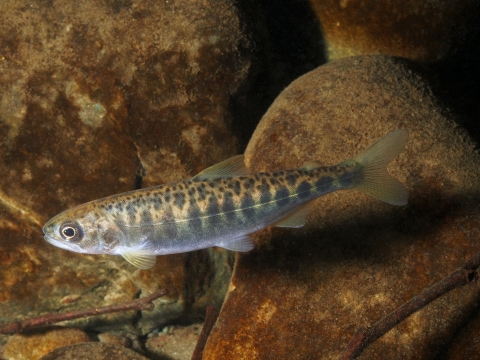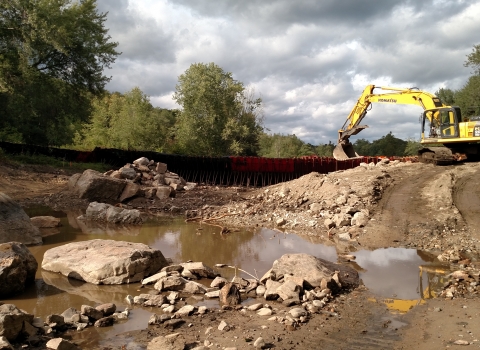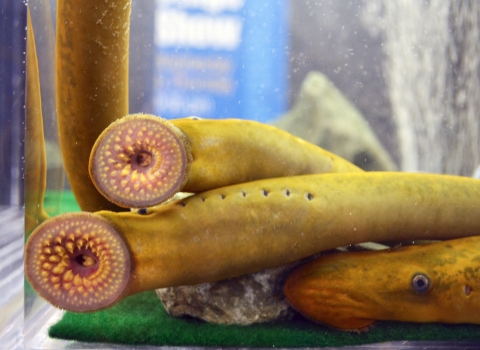The U.S. Fish and Wildlife Service announced 29 states will receive just over $70 million to support 43 projects that will address outdated or obsolete dams, culverts, levees and other barriers fragmenting the nation’s rivers and streams.
Millions of barriers around the world fragment rivers, block fish migration, and put communities at a higher risk of flooding. Obsolete or poorly designed dams, culverts, stream crossings, and levees keep fish and other aquatic species from moving freely to feed, migrate, and reproduce. These challenges put fish populations at risk, undermine the health of the rivers, and reduce fishing opportunities. These barriers also fragment aquatic habitats and are often more susceptible to flooding or drought. Improving aquatic connectivity can be an effective way to help conserve vulnerable species while building safer infrastructure for communities, improving climate resilience, increasing recreational opportunities, and strengthening local economies.
The Bipartisan Infrastructure Law Bipartisan Infrastructure Law
The Bipartisan Infrastructure Law (BIL) is a once-in-a-generation investment in the nation’s infrastructure and economic competitiveness. We were directly appropriated $455 million over five years in BIL funds for programs related to the President’s America the Beautiful initiative.
Learn more about Bipartisan Infrastructure Law investment of just over $70 million will address these outdated and obsolete barriers in 43 projects across 29 states. These funds build on the Service's 2022 and 2023 Bipartisan Infrastructure Law National Fish Passage Program investments of nearly $73 million for 79 projects across the U.S. The newly announced project list represents the third and fourth years of funding of a five-year, $200 million commitment to restore free-flowing waters, allowing for fish migration and protecting communities from flooding.
This diverse portfolio of aquatic conservation projects receiving funds will improve fish passage fish passage
Fish passage is the ability of fish or other aquatic species to move freely throughout their life to find food, reproduce, and complete their natural migration cycles. Millions of barriers to fish passage across the country are fragmenting habitat and leading to species declines. The U.S. Fish and Wildlife Service's National Fish Passage Program is working to reconnect watersheds to benefit both wildlife and people.
Learn more about fish passage and climate resilience, increase recreational opportunities, and strengthen local economies. This important work is accomplished through a multi-agency approach, working with and investing in states and local partners to yield transformational results for local communities.
Lower Skutik/St. Croix River Fishways (Maine) - This collaborative project with the State of Maine, Passamaquoddy Tribe, and other partners has the potential to support tens of millions of adult river herring returns annually, making their population the biggest in the United States and Canada. The fishways project will also contribute to the sustainability and economic viability of the local pulp, paper and fishing industries.
Conasauga Habitat Connectivity for Trispot Darters (Georgia) - This project will reconnect river habitats by removing undersized barrier culverts on county-owned roads. The culvert removals will directly benefit federally-threatened trispot darters and blue shiners, improve local transportation systems, and increase community infrastructure resilience during peak flows.
Enloe Dam Removal (Washington) - This collaborative project is co-sponsored by Trout Unlimited and the Confederated Tribes of the Colville Reservation and supported by both the Upper and Lower Bands of the Similkameen Indians. When implemented, the project will reconnect over 1,500 miles of habitat for steelhead trout, Chinook salmon, and Tribal trust species like Pacific lamprey, while also creating benefits for water quality, recreation, and flood risk reduction.
Otilla Dam Removal (Texas) - Led by the San Antonio River Authority, this project will remove a 1920s era dam that has become a human safety hazard as well as a complete barrier to aquatic species. The project will improve public safety, reduce flood risk, and reconnect 30 miles of upstream river habitat for species and recreational uses.
Upper Otter Tail River Connectivity Project (Minnesota) - This project is led by the Minnesota Department of Natural Resources with collaboration from the White Earth Band of Chippewa, Red Lakes Band of Chippewa, Minnesota Department of Transportation, East Otter Tail Soil and Water Conservation District, and other partners. It will connect 20 river miles and nearly 1,800 acres of aquatic habitat, contributing to lake sturgeon recovery and sustainability as well as connectivity for walleye, white sucker, mussels, and other aquatic species of concern. Increased fish passage provides fishing, wild-origin protein harvest opportunities, and improves sustainability of culturally significant fish populations for local Tribes. The project also contributes to regional transportation improvements by eliminating undersized culverts on a state highway, replacing them with climate resilient bridges.
FY24-25 National Fish Passage projects with funding from Bipartisan Infrastructure Law
The National Fish Passage Program: Connecting Watersheds and Communities
The National Fish Passage Program has decades of experience implementing infrastructure projects with partners. Under the Bipartisan Infrastructure Law we are bringing that experience to bear to foster collaboration between federal agencies, Tribes, states, and non-profit partners.
Since 1999, the program has worked with over 2,000 local communities, Tribes, and private landowners to remove or bypass over 3,400 barriers to fish passage and reopen access to over 61,000 miles of upstream habitat for fish and other animals. Staff have expertise in fish migration and biology as well as financial, engineering, and planning assistance to communities, Tribes, and landowners to help them remove barriers and restore rivers for the benefit both fish and people.
The rivers, streams, and coastal systems of North America once supported vast annual runs of fish such as Pacific salmon, American shad, blueback herring, Pacific lamprey and American eel. These species and many others, including some at-risk and listed species, depend on connected streams and high-quality habitat to survive. The U.S. Fish and Wildlife Service and the National Fish Passage Program are committed to reconnecting rivers for the benefit of all.
Federal Interagency Fish Passage Portal
The Federal Interagency Fish Passage Portal is a resource for anyone who needs information, funding, or technical assistance to improve fish passage and aquatic connectivity projects. We provide landowners and public lands managers the tools they need to access fish passage resources across the federal government.
The Fish Passage Portal will be a living repository of the best resources and information from across the federal government, in one free and easy to access location. It will be updated regularly to meet all your project needs from planning, to funding, to implementation.





